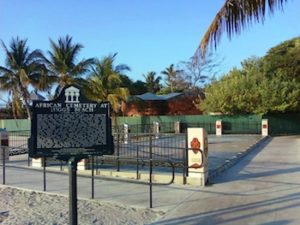
*On this date in 2002, a Consecration Ceremony for the Key West African Cemetery occurred. This occasion marked another chapter of closure in the history of Black Africans in America.
Key West was never a slave-trading port, but because of its unusual geography, it was often affected by the Middle Passage. A remote outpost poised along the maritime highway of the Gulf Stream current and very close to the plantations of Cuba, the small island saw several slave ships sail through, wrecked, or be forcibly brought to her waters.
In the spring of 1860, three slave ships intercepted by the US Navy in their efforts to stop the illegal trade in humans were brought to Key West. These American-owned ships were bound for Cuba, where the slave cargo would be sold to the thriving sugar plantations. A total of 1,432 Africans arrived from these ships and came with nothing. The 3,000 citizens of the island, led by the United States Marshal Fernando Moreno, built housing, donated clothing, and provided food and medical attention to them. For eighty-five days, the newly liberated refugees found shelter at Key West. But because of the horrific conditions they suffered aboard the slave ships, many Africans were quite ill, and 295 died.
They were buried in shallow sand graves on the island's southern shore. For three days in June of 2002, a team of archaeologists and volunteers conducted a Ground-penetrating Radar survey in the area of Higgs Beach to locate any evidence of the African Cemetery. Grids were laid out on the ground, and using a hand-towed antenna, radar signals were generated and their reflections measured. The data was collected and processed into a computer, showing clear images of the subsurface structures. A series of shallow graves were found near the sidewalk on the beach.
On this date, Prince Adegbolu Adefunmi sprinkled water on the ground over the site and performed an ancient African ceremony honoring and remembering the dead. Adefunmi performed the ceremony mainly in “Yoruba,” an African language from the region where the Africans buried at the site originated. Annually, services such as Fernanda Meier (shown) are held at the Florida burial site.